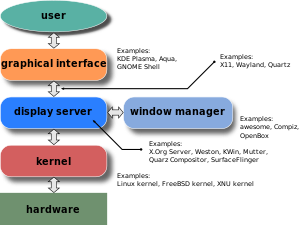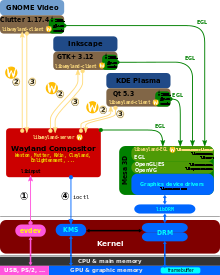A display server or window server is a program whose primary task is to coordinate the input and output of its clients to and from the rest of the operating system, the hardware and to and from each other. The display server communicates with its clients over the display server protocol, a communications protocol, which can be network transparent or simply network capable.
The display server is a key component in any graphical user interface, specifically the windowing system.
Contents
[hide]Available display server communications protocols[edit]
X.org[edit]
One example of a display server is the X Window System, which runs on top of the kernel. It receives data from evdev (a loadable kernel module which is usually compiled as part of the kernel and not as a module) and passes it to one of its clients. The display server also receives data from its clients; it processes the data, it does the compositing and passes the data to one of three kernel components – drm, gem or kms. The component writes the data into the framebuffer and content of the framebuffer is transmitted to the connected screen and displayed. X relies on GLX.
One of the implementations of display server concept is X Window System, in particular its actually used version – X.Org Server and Xlib and XCB client libraries. The X.Org Server is a display server, but in its current implementation it relies on a second program, the compositing window manager, to do the compositing. Examples are Mutter or KWin.
Notable examples of display servers implementing the X11 display server protocol are X.Org Server, XFree86, X11.app and Cygwin/X, while client libraries implementing the X11 display server protocol are Xliband XCB.
One tool called xev is a unix command which creates a window and then asks the display server to send information of events every time something happens to the window (like if it's resized, if any keys are pushed, if it's clicked it etc.) to the console.
Wayland[edit]
The Wayland display server protocol defines that the display server is responsible for the compositing, while each of its clients is responsible for the drawing. Thus, display servers as defined by the Wayland display server protocol, contain logic of a typical X compositing window manager and are also called Wayland compositors. Implementations are Weston, Mutter, KWin or Clayton. These programs additionally include the window manager and, for security reasons, also the screensaver (when standalone it exposes bare desktop if crashed or killed). Wayland compositors communicate with wayland clients over the Wayland display server protocol. This protocol defines that clients can directly write data into the framebuffer using the EGL rendering API. The display server still gets to decide which window is on top and thus visible to the user and also still is responsible for passing data regarding to input devices from evdev to its clients.
Display servers and clients implementing the Wayland display server protocol are employed not only in modern Linux desktop distributions but also in ones running on mobile devices, such as the mer-based Sailfish OS or the operating system running on the Vivaldi Tablet.
The only client library implementing the X11 display server protocol is libwayland-client.
Mir[edit]
The Mir display server protocol is different to X11 and Wayland. It is developed by Canonical Ltd. and is intended to be the display server of choice for Ubuntu.
There is only one program and one client library for the Mir protocol. They are the Mir display server and the libmir-client library, respectively.
SurfaceFlinger[edit]
For Android, another Linux-based operating system primarily for mobile devices, Google Inc. developed the display server SurfaceFlinger.[1][2]
Quartz Compositor[edit]
Quartz Compositor is the name of the component, that is fulfilling the tasks of a display server and of a window manager in the windowing system, that is being natively used by the Mac OS X family of operating systems.
References[edit]
See also[edit]
출처 - http://en.wikipedia.org/wiki/Display_server
'System > Common' 카테고리의 다른 글
| X.Org Server (0) | 2014.04.09 |
|---|---|
| Windowing system (0) | 2014.04.09 |
| X window manager (0) | 2014.04.09 |
| XDM(X Display Manager) (0) | 2014.04.09 |
| X.Org Server (0) | 2014.04.09 |









